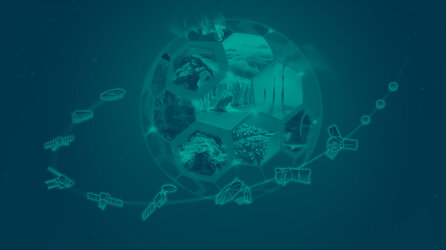Spotlight on the pulse of our planet
Satellites deliver crucial information to help solve what is our biggest global problem: climate change. As well as taking the pulse of our planet, satellite data are used in a myriad of daily applications, and are also used increasingly in business. It’s no surprise then that over 4000 people have flocked to Milan to hear the latest scientific findings on Earth’s natural processes and global change, and to learn about the wealth of new opportunities that Earth observation has to offer.
ESA holds its Living Planet Symposium – the largest Earth observation conference in the world – every three years, each time drawing more participants than the last. The current edition, which has been organised with support from the Italian Space Agency, got off to a flying start this morning in the heart of Milan, Italy.
Traditionally, the focus of this series of symposiums has been on Earth science – and while this still takes centre stage, the importance of international cooperation in developing satellite observing systems that bring the most benefits to society is also very much at the forefront of discussions.
In addition, the landscape of Earth observation is changing. Against the backdrop of commercial Earth observation and the digital revolution, participants will be talking about how satellite data and new technologies such as artificial intelligence and blockchain can benefit business, industry and science, and also ESA.

With all these topics, and more, to be presented and discussed in the days ahead, the symposium was opened by Milan’s Councillor for Urban Planning, Parks and Agriculture, Pierfrancesco Maran, who wished everyone a warm welcome from the city.
He noted, “Cites around the world are facing the issues of climate change and pollution, but while cities are part of the problem, they can also be part of the solution through better education and innovation.”
Participants were also welcomed by ESA’s Director General Jan Wörner. Stressing the importance of information from space to address the global challenges of climate change, energy and resources shortages, he said, “Earth observation is expanding the frontiers of knowledge – through this we understand climate change and much more.
“From space you don’t see borders and this is the same for us – the countries of Europe are working together for a coherent approach that includes common goals and a full integration of space to bring the biggest benefits to society.”
Deputy Director-General of the EC DG GROW, Pierre Delsaux, noted, “ClimateChange is not just a European issue, it is a world-wide issue. We work to involve, sometimes convince our partners around the word that new missions can give us clear scientific assessments of the changes happening to our planet.”

Recent demonstrations by students around the world make it clear that the young have serious concerns about the health of the planet and are pushing for action.
Young climate activist, Jakob Blasel from Fridays for Future talked passionately about his worries, “Our generation is the most conscious about climate change as we will have to live with the consequences in the next decades. I’m one of the people who fears the future.
“In my view, world leaders do not take the climate crisis seriously.”
The young are also in the spotlight this week. For the first time, the Living Planet Symposium is hosting over 2000 children with their own dedicated programmes. There are the Open Days available for 8–12 year olds and School Labs for 13–18 year olds. Students, for example, will be taking air pollution measurements, and much more.
With the environment very much in the news, many governments, institutes, businesses and individuals are making different choices to reduce the impact we are having on our fragile planet.
The EC’s Deputy Director General for Research and Innovation, Patrick Child, highlighted, “The transition towards a carbon-neutral economy and a sustainable Europe by 2030 requires advancing our knowledge of the Earth system, its dynamics and its interactions with human activities.
“There is an urgent need to develop instruments to better predict and mitigate the consequences of climate change.
“The global challenges our society faces requires knowledge-based policy-making, building on reliable observation systems, products and services.”
Mr Child’s words are at the heart of the symposium – as science and understanding is critical to addressing environmental issues.

ESA’s Director of Earth Observation Programmes, Josef Aschbacher, said, “I am thrilled to see so many people here – a true testament to the growing interest and importance of what Earth observation brings.
“We are looking forward to hearing the latest scientific results. And, with ESA’s next ministerial council, Space19+, in November, we will also be talking about how we will take Earth observation into the future, particularly through innovation and partnerships.
“But crucially we need the engagement of young people, the scientists of tomorrow.”
With eyes now on Milan, the week not only promises to be a week of discovery about our changing planet, but also showcases how society at large benefits from Earth observation.
We are changing our natural world faster than at any other time in history. Understanding the intricacies of how Earth works as a system and the impact that human activity is having on natural processes are huge environmental challenges. Satellites are vital for taking the pulse of our planet, delivering the information we need to understand and monitor our precious world, and for making decisions to safeguard our future. Earth observation data is also key to a myriad of practical applications to improve everyday life and to boost economies.










